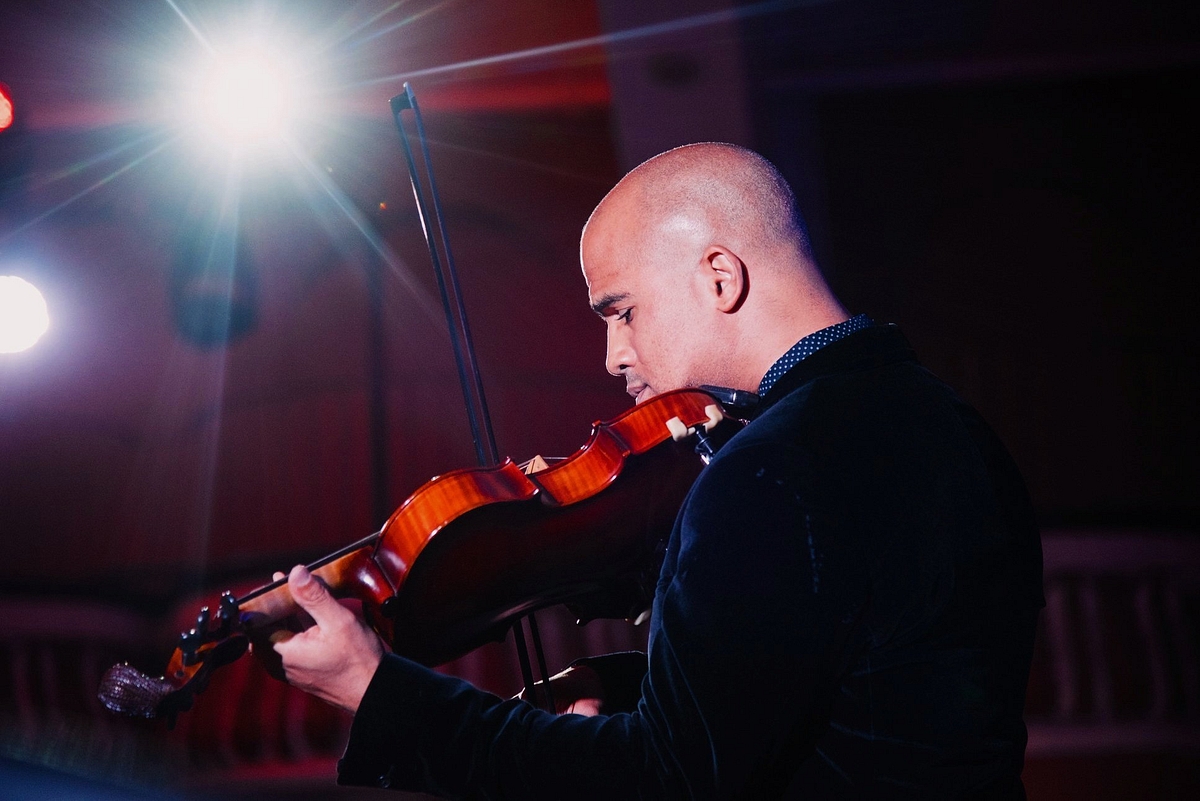
Composer Daniel Bernard Roumain.
The New Haven Symphony Orchestra, one of a few American orchestras working to address injustices in the past and present of professional classical music, made two important — and increasingly common — choices at their Sunday afternoon concert at SCSU’s Lyman Hall.
The first choice was in the selection of programming. Music Director Alisdair Neale and the NHSO presented an afternoon that embraced the symphonic idiom, but largely from the viewpoint of Black composers in the 20th and 21st centuries. The earliest piece presented was Florence Price’s First Symphony, dating to 1931, while the entire first half of the program was made up of compositions from 2020 and 2021.
The second choice was to pick works that, in the first half, all addressed contemporary events. Two directly mourned the deaths of two Black women — Sandra Bland, and Breonna Taylor — by police violence, and one responded to the unfolding climate crisis.
These are both important choices. To those who wonder “why orchestras” in 2023, it is important to provide a sense that classical music is aware of and conversant with the wider world — that it can engage anyone, not just those with composition degrees or music appreciation courses on cassette. And that it can accomplish some of that by embracing some of the diversity that already exists within the canon, past and present.
Sunday’s concert showed that those steps are important, but they are not bulletproof. The concert felt a bit uneven in energy throughout, some of the highs (and pianissimo moments) subverted by a larger-than-normal dose of audience noise, like cell phones and loud yawns.
The concert began, unusually, with Daniel Bernard Roumain’s “Why Did They Kill Sandra Bland?,” a piece for solo cello, which for this performance was paired with a poem by local poet and activist Sun Queen. Both components on their own were thoughtful, and it would have been perhaps nicer to hear them both side by side rather than together. Cellist Jeffrey Ziegler took to the piece, a grieving meditation in C minor, with great restraint, avoiding any sense of pathos while the work lingered on a state of disbelief at the shocking facts of Bland’s murder. Queen’s poem, in contrast, seemed ready to transcend that state of grief, and there were moments of dissonance between her more transformative phrases and Roumain’s sparse vision. Almost as impactful was Queen’s raised fist in response to the audience’s applause, a stark image against an otherwise empty stage.

Joel Thompson.
The orchestra then filtered in for Joel Thompson’s “breath/burn: an elegy for solo violoncello and orchestra.” The NHSO has frequently worked with Thompson in the last several years, including as a part of last year’s season opener, and it is this reporter’s hope that this collaboration will continue.
Despite its mournful subject matter — the murder of Breonna Taylor during the improper execution of a “no-knock” warrant — Thompson approached the music with real fluidity of expression. Most often it avoided the tragedy, focusing on vibrant and adventurous harmonies that sought to portray Taylor apart from her tragic end. Moments where Ziegler and the strings worked rhythmically against the rest of the orchestra colored this initial optimism, as the work slowly introduced some echoes of the external forces that ended her life. Both as a piece of narrative and as an emotional reaction, it was triumphant, clocking in at seven minutes but carrying with it a disproportionately large emotional impact.

Mark Adamo.
Next was Mark Adamo’s “Last Year: Concerto for Cello and String Orchestra.” This piece had a lot of strong elements to it, and Ziegler delivered some incredible displays of texture, both unaccompanied and in dialogue with the orchestra. A reaction to the climate crisis and a musical response, in some oblique ways, to Vivaldi’s “Four Seasons,” the concerto was at its best when the orchestra swirled uneasily, giving an uncannily accurate voice to what is being termed “climate anxiety.”
Some of the most striking moments were in the first movement, when phantasmal chords from piano, harp, and bowed vibraphone emerged out of the fading movement of the strings. But there were long stretches, like those driven by sometimes grotesque reharmonizations of familiar melodies quoted from Vivaldi, without much for a listener to grab onto — many beautiful moments that sometimes came and went quickly without much emphasis given to one or the other. Neither the audience noise nor the more dry acoustic of Lyman Hall did any favors to the many quiet and solo moments Adamo relied upon with this piece.
In his opening remarks, Neale said that he believes Florence Price’s First Symphony, and her music at large, has in the last few years taken its rightful place in the American canon of orchestral music, after neglect in and after her own time due to her identity as a Black woman.
To hear it on Sunday felt to some degree rewarding — and to another, alien. Like Copland’s Appalachian Spring, which the NHSO performed in October, Price’s Symphony No. 1 feels very much of its time, reflecting a vision of Black culture, as many Black American composers did, through pentatonic melodies and expanded percussion sections. Considering how the development of Black orchestral music has continued since Price’s time, it is worth occasionally asking how faithfully these devices represented Black American culture in the concert hall. (At the time of its composition, the symphony was the recipient of the Wanamaker Prize for composition.)
Price employed an impressive formal rigor as melodic fragments developed in a logical way — but this at times seemed to constrain her voice, causing some passages to feel more inevitable. The orchestra rose to meet the work’s best moments, and the third and fourth movements in particular provided an energetic ending to the program. And it felt a world — or 90 years — away from the work on the first half of the program.

There is another side to the Breonna Taylor story
https://m.youtube.com/watch?v=kt6cw3VQqvk&pp=ygUYc2hvdHMgZmlyZWQgcG9kY2FzdCBzd2F0